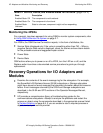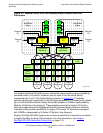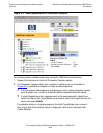
Processors and Components: Monitoring and
Recovery
HP Integrity NonStop NS-Series Operations Guide—529869-005
9-4
Monitoring and Maintaining Processors
In summary, these terms describe the NSAA processor:
Monitoring and Maintaining Processors
To monitor processors, use OSM, the ViewSys product, and other tools. Monitoring
and maintaining processors includes:
•
Monitoring Processors Automatically Using TFDS on page 9-4
•
Monitoring Processor Status Using the OSM Low-Level Link on page 9-5
•
Monitoring Processor Status Using the OSM Service Connection on page 9-5
•
Monitoring Processor Performance Using ViewSys on page 9-7
•
Monitoring EMS Event Messages on page 4-1
Monitoring Processors Automatically Using TFDS
HP Tandem Failure Data System (TFDS) should be used to proactively monitor
processors and manage processor halts. Configured and running before a halt occurs,
TFDS can help determine the type of recovery operation needed and:
•
If TFDS determines that the entire processor should be dumped be reloading, it
automatically dumps, then reloads the processor.
•
If TFDS determines that only the processor element (PE) for one Blade Element
needs to be dumped, it reloads the processor, excluding that Blade Element,
dumps the Blade Element, then reintegrates it back into the running processor.
•
Collects the files necessary to analyze the problem.
•
Sends halt information message to the EMS collector. If configured in OSM, a
dial-out message is sent to HP Global Support to notify them of the halt.
For more information on configuring and using TFDS, see the Tandem Failure Data
System (TFDS) Manual.
Term Description
Blade
Complex
Consists of two Blade Elements (in a duplex system) or three Blade
Elements (in a triplex system) and up to four logical processors and their
associated LSUs. An Integrity NonStop system includes up to four Blade
Complexes.
Blade
Element
Consists of a chassis, processor board containing two or four PEs (one
representing each logical processor in the Blade Complex), memory, I/O
interface board, midplane, optics adapters, fans, and power supplies.
Blade Elements are mounted in a 19-inch computer equipment rack.
Processor
element (PE)
A single Itanium microprocessor with its associated memory. A PE is
capable of executing an individual instruction stream and I/O
communication through fiber-optic links.
Logical
processor
One PE from each Blade Element executing a single instruction stream. A
duplex system has two PEs forming a logical processor. A triplex system
has three PEs.


















